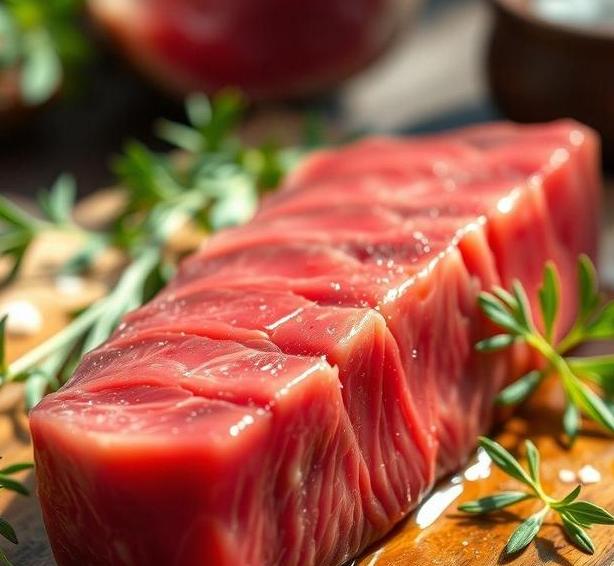Can Ahi Tuna Go Bad : What You MUST Know
Ahi tuna, also known as yellowfin tuna, is one of the most popular types of tuna on the market. Whether you’re a sushi enthusiast or a fan of grilled tuna steaks, its rich, deep flavor and meaty texture are hard to beat. But, as with any fresh seafood, knowing how to properly handle, store, and identify spoilage is essential to ensuring both safety and quality. Have you ever wondered how long Ahi tuna lasts, or how to tell if it’s gone bad? In this guide, we’ll dive into the shelf life of Ahi tuna, how to spot signs of spoilage, and the best ways to store it. Let’s get into all the details you need to enjoy this delicious fish without worrying about waste or health risks.
Can Ahi Tuna Go Bad?
The simple answer is yes-Ahi tuna can absolutely go bad. Like all seafood, it’s highly perishable and prone to spoiling if not stored or handled properly. The freshness of Ahi tuna is key to its flavor and texture, but unfortunately, it doesn’t last indefinitely. It’s crucial to understand that Ahi tuna is not just any piece of fish; it’s delicate, with a soft flesh that’s vulnerable to bacteria and spoilage once it’s exposed to air and changes in temperature. Whether you’re buying fresh, frozen, or sushi-grade tuna, knowing when and how it starts to deteriorate can save you from unpleasant surprises.
Shelf Life For Ahi Tuna

The shelf life of Ahi tuna depends on several factors, including how fresh it was when you bought it, how it’s stored, and whether it’s been cut or prepared in any way. Here’s a breakdown of the typical shelf life for different forms of Ahi tuna:
-
Fresh Ahi Tuna (Raw, Uncooked)
- In the fridge: If you buy fresh Ahi tuna from the market, it will generally last 1-2 days in the refrigerator. Ideally, it should be consumed within 24 hours for the best taste and texture, but it might still be okay for up to 48 hours if stored properly.
- In the freezer: Fresh Ahi tuna can last up to 2-3 months in the freezer. If you’re not planning to use it immediately, freezing it helps maintain its quality for a longer period.
-
Frozen Ahi Tuna (Uncooked)
- In the freezer: If the Ahi tuna is already frozen when you purchase it, it should maintain its best quality for 6-8 months in the freezer. While it may still be safe to eat beyond this, the texture and flavor could degrade over time.
- Thawed Ahi Tuna: Once thawed, it’s recommended to consume Ahi tuna within 24-48 hours to ensure it doesn’t spoil.
-
Cooked Ahi Tuna (Grilled, Seared, Etc.)
- In the fridge: Cooked Ahi tuna can last about 2-3 days in the fridge. Keep it tightly wrapped or in an airtight container to prevent it from drying out or absorbing odors from other foods.
- In the freezer: If you want to store cooked Ahi tuna for longer, you can freeze it, though its quality might drop a bit. It can last up to 2-3 months in the freezer.
Common Signs Of Spoilage
It’s essential to know the warning signs when Ahi tuna goes bad, as consuming spoiled fish can lead to foodborne illnesses. Here’s what to look for:
-
Smell
One of the most obvious signs of spoilage is a sour, ammonia-like smell. Fresh Ahi tuna has a clean, oceanic smell, but when it begins to spoil, it will give off an off-putting odor. If the fish smells particularly strong or unpleasant, it’s time to toss it.
-
Color Changes
Fresh Ahi tuna should have a bright red or deep pink color. As it begins to spoil, the flesh will lose its vibrant hue and turn a dull brown or grayish tone. The color change often indicates oxidation, which is a sign that the fish is no longer safe to eat.
-
Sliminess
Fresh Ahi tuna should have a firm, moist texture. If you notice the fish feels slimy, sticky, or tacky, this is a clear indication that bacteria have started to grow, and it should not be consumed.
-
Texture
Ahi tuna that has gone bad may feel mushy or overly soft when touched. Fresh tuna should feel firm to the touch, even when it’s raw. If the texture is noticeably off or the fish falls apart easily, it’s a sign of spoilage.
-
Off Taste
If you happen to taste it and the flavor is sour, bitter, or off in any way, this is another clear signal that the tuna is no longer good.
How To Store Ahi Tuna?

Storing Ahi tuna correctly is the key to maintaining its freshness. Here are the best practices for different storage scenarios:
-
For Fresh Ahi Tuna (Refrigeration)
- Place the tuna in the coldest part of your fridge, ideally between 32°F to 38°F (0°C to 3°C).
- Wrap the tuna in plastic wrap or wax paper, then place it in an airtight container or resealable bag to prevent exposure to air and contaminants.
- If you bought it at a market, it’s a good idea to ask the fishmonger for ice or bring an ice pack with you to keep the tuna as cool as possible on your way home.
-
For Frozen Ahi Tuna
- Wrap the fish tightly in plastic wrap, aluminum foil, or freezer paper. You can also place it in a vacuum-sealed bag to prevent freezer burn.
- For extra protection, place the wrapped tuna in a heavy-duty freezer bag to prevent air from getting in.
- Label the bag with the date of freezing so you can easily track how long it’s been in the freezer.
-
For Leftover Cooked Ahi Tuna
- Store cooked tuna in an airtight container or tightly wrapped in plastic wrap.
- Keep it in the fridge for up to 3 days or in the freezer for 2-3 months if you don’t plan to eat it right away.
Expert Tips
If you want to ensure the best quality and safety for your Ahi tuna, here are some expert tips:
- Buy it Fresh: Try to buy your Ahi tuna from a reputable source where the fish is properly handled and stored. If it’s not sold with a clear ’use by’ or ’sell by’ date, ask the fishmonger when the tuna was caught or delivered.
- Use Ice: If you’re not cooking the tuna right away, consider bringing an insulated cooler with ice to keep the fish cold during transport.
- Check for Sushi-Grade Tuna: If you plan to eat your Ahi tuna raw, make sure it’s labeled as sushi-grade or sashimi-grade, which means it has been frozen to kill parasites and bacteria. Always consume it as soon as possible to enjoy it at its freshest.
- Avoid Cross-Contamination: If you’re cutting or preparing the Ahi tuna yourself, ensure that you use a clean cutting board and knife, and sanitize everything after handling raw fish to avoid bacterial contamination.
- Don’t Over-Handle It: Tuna is delicate and can lose its flavor and texture if mishandled. Always handle it as little as possible and store it immediately after purchase.
FAQs
How Long Can Raw Ahi Tuna Stay Fresh In The Fridge?
Raw ahi tuna can generally stay fresh in the fridge for 1 to 2 days if stored properly in an airtight container or tightly wrapped in plastic wrap. It is best to consume it as soon as possible to ensure maximum freshness and quality.
Can Ahi Tuna Go Bad If It Is Frozen?
Yes, while freezing ahi tuna can extend its shelf life, it can still go bad over time. If kept in the freezer, ahi tuna can last 2 to 3 months for optimal flavor and texture. After that, it may start to degrade in quality.
What Signs Indicate That Ahi Tuna Has Gone Bad?
Signs that ahi tuna has gone bad include a sour or ammonia-like odor, slimy texture, discoloration (such as browning or dullness), and a mushy or overly soft feel. Any off-putting or unusual smell is a strong indicator that it should not be consumed.
Can Cooked Ahi Tuna Go Bad?
Yes, cooked ahi tuna can go bad. It should be stored in the refrigerator and consumed within 3 to 4 days. If left at room temperature for more than 2 hours, cooked tuna should be discarded due to the risk of foodborne illness.
How Should Ahi Tuna Be Stored To Prevent It From Going Bad?
To prevent ahi tuna from going bad, store it in the coldest part of your refrigerator, ideally at temperatures below 40°F (4°C). Wrap the fish tightly in plastic wrap or place it in an airtight container. If not planning to use it right away, freezing is an option.
Can I Tell If Ahi Tuna Has Gone Bad Just By Looking At It?
While discoloration is a clear indicator, it’s not always enough to determine if ahi tuna has gone bad. A fresh piece of ahi tuna is typically bright pink to deep red in color, and any dullness, browning, or a change in texture may indicate spoilage.
How Can I Extend The Shelf Life Of Fresh Ahi Tuna?
To extend the shelf life of fresh ahi tuna, it’s crucial to store it properly. Keep it in a well-sealed container or wrap it tightly in plastic wrap, and store it on ice or in the coldest section of the refrigerator. Freezing can also preserve its freshness for longer.
Can Ahi Tuna Still Be Safe To Eat If It’s Past Its Expiration Date?
The expiration date on ahi tuna packaging is a guideline for freshness, but it is not an absolute guarantee of spoilage. If the tuna has been stored properly and shows no signs of spoilage, it may still be safe to eat, although it’s best to inspect it carefully for any off smells or textures.
What Is The Best Way To Thaw Frozen Ahi Tuna?
The safest way to thaw frozen ahi tuna is to place it in the refrigerator overnight. If you need to thaw it more quickly, you can use a cold water bath in a sealed bag, changing the water every 30 minutes until the tuna is thawed.
Is It Safe To Eat Ahi Tuna That Has Been Left Out Overnight?
No, it is not safe to eat ahi tuna that has been left out overnight. Perishable foods, including raw fish, should not be left out for more than 2 hours, as bacteria can multiply quickly at room temperature and pose a serious health risk.
